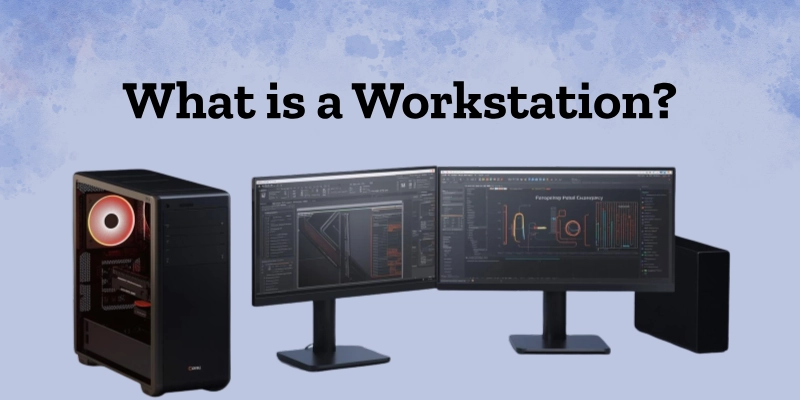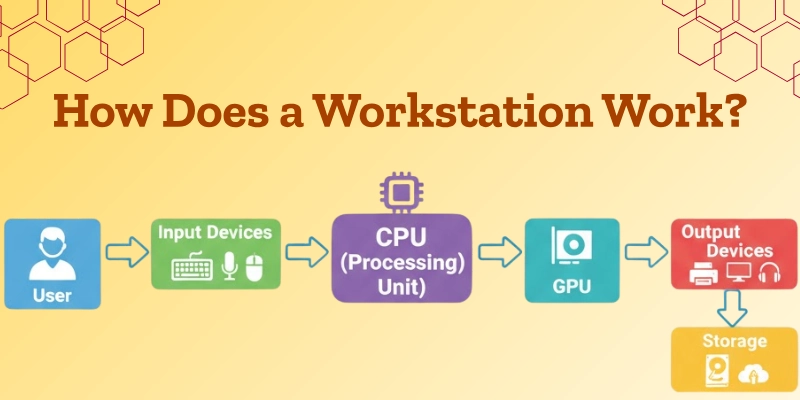What is a Workstation and How Does it Work
Published: 28 Oct 2025
Have you ever seen a powerful computer that looks like a normal PC but can do much more? That’s a workstation.
A workstation is a high-performance computer used for technical and professional work. Engineers, designers, video editors, and researchers use it for heavy tasks.
In this article, you will learn what is workstation, how it works, its types, features, comparison, and uses of a workstation.
What is a Workstation?
A workstation is a high-performance computer made for specialized, technical, and scientific tasks. It offers more power, memory, and speed than a normal desktop computer. Workstations are built to handle heavy workloads, such as 3D modeling, video editing, animation, and engineering design.
They are often used in offices, studios, and research labs where people need to run complex software that requires strong hardware support.

A workstation may look like a regular PC, but inside, it is much more powerful. It includes advanced hardware components like faster processors, large RAM, and professional-grade graphics cards.
This makes it perfect for running demanding programs without freezing or crashing. For example, while a normal desktop might struggle with big design files or video projects, a workstation can handle them easily and smoothly.
In short, a workstation is a super version of a desktop, built for speed, accuracy, and long working hours.
Example:
For example, an architect designing buildings in AutoCAD or a video editor using Adobe Premiere Pro works on a workstation computer because it is fast, strong, and reliable.
Comparison with a Personal Computer
A workstation is different from a personal computer in many ways. While both look similar from the outside, a workstation is built for professional work that needs more power and memory.
| Feature | Workstation | Personal Computer |
| Processing Power | High | Medium |
| Purpose | Professional tasks | Everyday use |
| Memory | Larger RAM | Basic RAM |
| Cost | Expensive | Affordable |
| Example Use | 3D Design, Data Analysis | Internet, Office Work |
A workstation in a computer system is mainly used for advanced tasks, while a personal computer is made for simple daily activities. This shows that a workstation is designed for speed, power, and accuracy, making it ideal for engineers, designers, and researchers.
Components of a Workstation
A workstation is made up of several important hardware parts that help it perform heavy tasks smoothly. Each part has a special job that keeps the system fast, stable, and powerful.
Let’s understand the main components of a workstation in simple words.
| Component | Function |
| Processor (CPU) | The brain of the workstation. It performs complex calculations and handles multiple tasks much faster than normal CPUs. |
| RAM (Memory) | Helps in multitasking and running large software programs without slowing down. More RAM means smoother performance. |
| Storage (SSD/HDD) | Stores all your data, files, and software. SSDs are used for speed, while HDDs offer large storage capacity. |
| Graphics Card (GPU) | Manages 3D graphics, rendering, and animation. It’s very important for designers, architects, and video editors. |
| Motherboard | The main board that connects all components together and allows them to communicate properly. |
| Cooling System | Keeps the temperature low when the workstation runs heavy software for long hours. It protects the parts from overheating. |
| Power Supply Unit (PSU) | Provides stable electricity to all hardware parts so the system works safely and efficiently. |
Each of these workstation hardware parts plays a key role in maintaining the overall workstation structure, making it strong, fast, and reliable for professional use.
Key Features of a Workstation
Workstations are designed for speed, power, and professional use. They have many special features that make them stronger than normal computers.
Let’s look at the main characteristics of a workstation computer in simple words.
- High Processing Speed:
A workstation uses advanced processors like Intel Xeon or AMD Ryzen Threadripper. These CPUs handle complex programs smoothly and make the system very fast. - Large Storage and RAM:
Workstations come with big storage drives and large RAM. This helps them manage big files and heavy programs such as 3D design software or scientific simulations without lag. - Reliable and Durable:
They are made for 24/7 work. The parts are strong and reliable, so the system can run for long hours without overheating or crashing. - Superior Graphics:
Workstations use professional GPUs such as NVIDIA Quadro or AMD Radeon Pro. These graphics cards make them perfect for video editing, 3D modeling, and animation. - Multi-Monitor Support:
Many professionals use two or three screens at once. This feature improves workflow and makes multitasking faster and easier. - Expandable and Upgradable:
One of the best features of a workstation is that it can be upgraded easily. You can add more RAM, storage, or graphics cards whenever needed.
These powerful workstation specs make it the best choice for professionals who need both speed and stability in their work.
Types of Workstations
There are different types of workstations made for different kinds of work. Each one has a unique design, purpose, and level of portability.
Let’s learn about them in simple words.
- Tower Workstation:
A tower workstation looks like a normal desktop computer but is much more powerful. It has more space for upgrades like extra RAM, storage, or graphics cards.
Examples include the HP Z Series Tower and Dell Precision Tower.
These are commonly used in design studios and engineering labs where performance and flexibility are important. - Rack Workstation:
A rack workstation is mounted in racks, usually found in data centers or network rooms. It is controlled remotely and designed for teamwork or large-scale computing.
It’s ideal for rendering farms, servers, and IT departments that need powerful systems running all the time. - Mobile Workstation:
A mobile workstation is like a powerful laptop made for professionals who travel or work outside the office.
An example is the Lenovo ThinkPad P Series, which combines portability with high performance.
It’s used by architects, designers, and engineers who need workstation power in a laptop form. - All-in-One Workstation:
An all-in-one workstation combines the monitor and CPU into a single compact unit. It saves space and looks neat on desks.
It’s commonly used in offices or creative studios where style and space matter.
An example is the Apple iMac Pro.
Uses of Workstation
Workstations are powerful tools made for professionals who need speed, accuracy, and high performance.
Let’s look at some real-world applications of workstation computers and how they are used in different fields.
- Engineering and Design:
Workstations are widely used in engineering and design fields. Engineers use them for CAD drawings, 3D modeling, and testing new designs.
For example, mechanical engineers use software like AutoCAD or SolidWorks to create machine parts and test them digitally before building real models. - Animation and Video Production:
In animation studios and video editing rooms, workstations handle rendering, visual effects, and high-quality video editing.
They help artists and editors work with large 4K or 8K video files smoothly without lag. Popular software like Adobe Premiere Pro, Blender, and Maya runs best on powerful workstation systems. - Architecture:
Architects use workstations to design and visualize buildings in detail.
Software like Revit and SketchUp helps them create 3D models, view floor plans, and make design changes quickly.
This makes construction planning faster and more accurate. - Scientific Research:
In research labs, scientists use workstations for data analysis, simulations, and scientific experiments.
For example, researchers studying climate change or genetics rely on workstation computers to process large amounts of data and run complex calculations. - Business and IT:
Businesses and IT companies use workstations for big data analysis, software development, and financial forecasting.
They are also useful for server management, AI training, and network simulations, where high speed and reliability are essential.
Advantages and Disadvantages of Workstation
Like every computer system, a workstation also has its pros and cons. Let’s look at the main advantages and disadvantages of a workstation in a simple way.
| Advantages | Disadvantages |
| High performance | Costly |
| Reliable for heavy work | Power-hungry |
| Expandable and customizable | Large in size |
| Professional graphics | Needs technical knowledge |
| Long-lasting | Not portable (for tower models) |
A workstation is built for professionals who need power and precision, while a desktop computer is made for everyday users who need basic performance.
If you are a designer, editor, or engineer, a workstation is best for you. But if you just browse, type, or watch videos, a desktop computer is enough.
Difference Between Workstation and Desktop Computer
Many people think a workstation and a desktop computer are the same, but they are quite different in purpose and power. This simple comparison helps beginners understand the main differences between a workstation vs PC.
| Feature | Workstation | Desktop Computer |
| Processor | High-end (Xeon, Threadripper) | Regular (Core i5/i7) |
| RAM | 16–128 GB | 4–16 GB |
| Graphics | Professional GPUs | Basic GPUs |
| Use Case | Professional work | Home & office use |
| Cost | Expensive | Cheaper |
| Durability | Long-term heavy use | Normal workload |
The main difference between a workstation and a personal computer is power and purpose; workstations are made for professionals, while desktops are made for regular users.
Importance of Workstation in the Modern World
In today’s fast and tech-driven world, the importance of a workstation is greater than ever. It helps professionals complete creative and technical projects quickly and smoothly.
A workstation offers the speed, power, and stability needed for demanding work like 3D modeling, animation, engineering, and scientific research. Because of its strong hardware, it reduces lag and downtime, helping professionals stay focused and productive.
The role of the workstation in the computer field is huge. It supports industries that shape modern technology, from AI development and 3D printing to data analysis and simulation.
In short, a workstation is not just a computer; it is a tool for innovation. It allows engineers, designers, and researchers to bring their ideas to life faster, more accurately, and more efficiently.
That’s why a workstation is important; it powers the digital tools and creative work that move the modern world forward.
Examples of Workstations
There are many workstation computer examples available today, built by top brands known for their power, reliability, and speed. These systems are designed to handle professional tasks like 3D design, animation, and video editing with ease.
| Brand | Model Example | Best Use Case |
| HP Z Series | Z4, Z8 | Engineering & Design |
| Dell Precision | 7920, 5860 | Animation & Video Editing |
| Lenovo ThinkStation | P920 | 3D Modeling & Architecture |
| Apple Mac Studio | M2 Ultra | Video Production & Editing |
These famous workstation models are trusted by professionals around the world. For instance, engineers often choose the HP Z Series for CAD work, while video editors prefer the Apple Mac Studio for its smooth editing performance.
These workstation examples show how different brands create powerful systems for every kind of professional work.
Internal Working Diagram
A workstation is a smart and powerful computer that performs complex tasks with speed and accuracy. Understanding its working process helps us see how it turns user commands into high-quality results like designs, images, or data models.

This smooth flow shows the complete workstation working process, from taking input to displaying high-quality results.
- The user gives commands through input devices like a keyboard or mouse.
- The CPU (Central Processing Unit) processes the data, performs calculations, and sends graphics-related tasks to the GPU (Graphics Processing Unit).
- The GPU handles images, videos, and 3D graphics, then sends the results to output devices like monitors or printers.
- Finally, all the processed data is saved in storage for future use.
The internal structure of a workstation is designed for speed and efficiency, making it perfect for complex and professional tasks.
Conclusion
In this guide, we’ve learned about the meaning, components, types, features, and uses of workstation computers in the modern world. They play a key role in boosting creativity and productivity across many industries.
A workstation is a powerful and reliable computer made for professionals who handle demanding tasks like design, animation, and research. It delivers high speed, durability, and accuracy, helping you complete complex projects with ease.
Ready to level up your work? Explore the best workstation computers today and experience smoother, faster, and smarter performance.
FAQs
Got questions? Here are some quick answers about workstation computers.
A workstation is a high-performance computer designed for technical and professional work. It handles heavy tasks like 3D design, animation, and data analysis.
Most workstations use between 16 GB to 128 GB of RAM. The amount depends on the type of work and software used.
A workstation usually has 1 TB to 8 TB of storage or more. It often includes both SSDs for speed and HDDs for extra space.
Yes, a workstation is more powerful and reliable than a regular desktop. It’s built for continuous, high-performance tasks.
A workstation works best with a high-resolution monitor, like 4K or UltraWide. These monitors give better color accuracy and screen space.
It is mainly used for professional work such as design, video editing, and scientific research. Workstations are built to manage heavy workloads smoothly.
A proper workstation setup includes a powerful CPU, large RAM, a professional GPU, and an ergonomic desk arrangement. It ensures comfort and high performance during long working hours.

- Be Respectful
- Stay Relevant
- Stay Positive
- True Feedback
- Encourage Discussion
- Avoid Spamming
- No Fake News
- Don't Copy-Paste
- No Personal Attacks

- Be Respectful
- Stay Relevant
- Stay Positive
- True Feedback
- Encourage Discussion
- Avoid Spamming
- No Fake News
- Don't Copy-Paste
- No Personal Attacks





